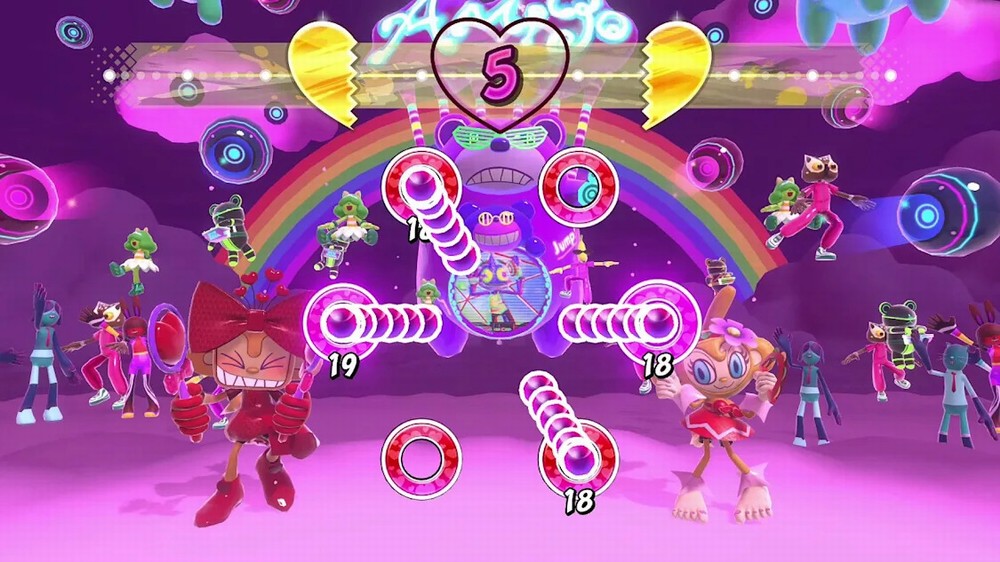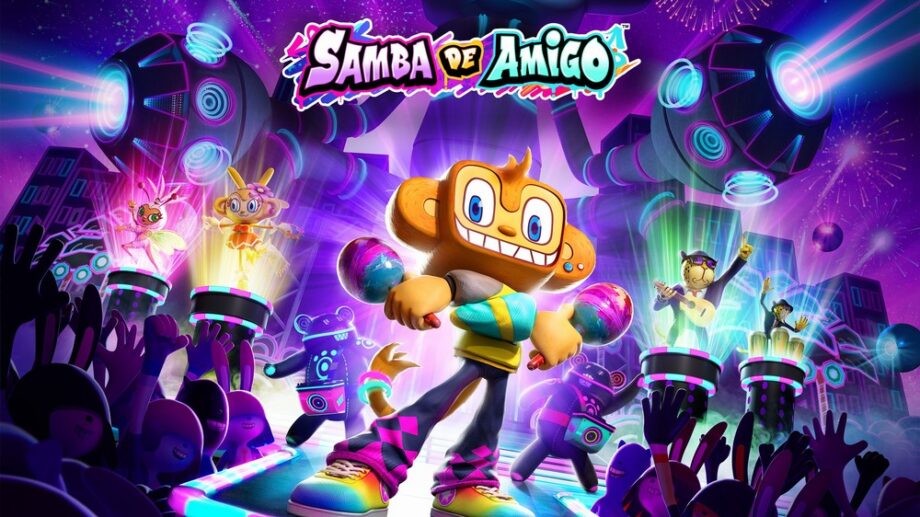SEGA has a vast library of unique IPs, and yet they rarely refuse to leave the arms of Sonic, Yakuza, Persona, and Bayonetta. At least Nintendo has a variety of franchises they try to use repeatedly, even if some are still waiting in the garage for another time (oh hi F-Zero). So, seeing SEGA wheeling back out the Samba De Amigo franchise for another spin was surprisingly great. While there is a weird little twist to it thanks to a mobile version popping up on the Apple Arcade called Party To Go, the game is still a great and fun time on the Switch.
The gameplay is a basic rhythm game, like Guitar Hero, Rock Band, or Friday Night Funkin’; match the beats with your motions. The difference this time is that you’re doing this on maracas, and you’re on a 6-note system. Raise the joy-cons to hit the upper notes, keep them level to play the notes on the middle level, and point them down to hit the lower notes. It’s not about how they’re positioned within the room, but rather where they are pointing. There still is a system that gives you more points when you perform perfectly instead of being a bit early or late, encouraging you to try and get better at the game. It gives some good wiggle room for the motion controls. Perhaps, a bit too much room. There is no penalty for shaking the joy-cons where there are no notes, probably to accommodate for how moving the joy-cons could trigger the shaking motion. And if the motion controls are still too much for you, there’s a new button option that replaces the motion controls with a button format. While the button controls are functional, the motion controls just worked too well and fit just right that there wasn’t a need to switch over to the button format.

Alongside hitting notes, you also have to do certain motions and movements, shaking your joycons in the proper way that the screen instructs you to do. They can be squats, dances, or poses. There is even a musical note that if you hit takes you to a rhythm minigame. These games can either forgo the 6-note system to have you hi-five oncoming fans, play a round of baseball, or even mimic Amigo’s hands, or they can work their way into the 6-note system, messing with the size of the board, increasing, decreasing, or randomly changing the speed of the song, or even instructing you to hit certain notes with certain hands. It’s a fun way to keep you on your toes and to keep earning points.
In comparison to the original Dreamcast game and remake on the Wii, this version of Amigo is a lot more modern. There’s more of a focus on the songs you would see on the top 10 song charts, and lost a bit of its original samba music that made it stand out. This also extends to the locations in the game, where they are given a neon 80’s aesthetic look to them. A whole lot of bright pinks and blues are everywhere, with the locations being more urban and less Latino. Think the original Samba De Amigo game given a dose of Mousercise, an old retro Disney program that had Disney characters exercising to music. Amigo’s outfit even got a new updated look that has him in fitness attire. That isn’t to say that this new game isn’t bad with its graphics and music. If this was a new franchise from SEGA, it would not have had to worry about this departure, and just enjoy how amazing the visuals are. The musical choice isn’t even that bad, as the songs are a good mix of genuinely good music, being both classic chart toppers, and still having some nice Samba songs (though the omission of the Samba De Amigo song by Bellini, a song that was once in the original game, is incredibly head scratching). With SEGA promising more songs them providing song packs till the end of the year, it would be nice to see how varied the library can get at the end of it all.

The graphics still look pretty amazing, and add to the party aesthetic, making it look like it is a rave. The different stages you can go around on vary and are just pure eye candy. Whenever you do good or bad, the atmosphere changes to accommodate your performance, getting more lively or deserted depending on how well you’re doing. The character models all look very cartoonish and bright as well, giving off a cohesive world while still being very much its unique universe with their characters.
Speaking of Amigo, not only does his music and stage get an update, but so does Amigo himself with his own wardrobe. If you want to change Amigo’s look around, you’re given plenty of options. From what he’s wearing on his head, to the sound his maracas make, Amigo has a lot of ways to get dressed up to fit whatever you’re feeling. You can even unlock his old wardrobe if you’re feeling nostalgic. You can unlock more outfits with coins you get from completing songs or leveling up your progress bar. There’s even a secondary currency you can use coins to buy to unlock more premium cosmetic changes, alongside getting certain level-ups or winning the World Party mode.

There’s more to this game than just popping on a song and playing it for a quick time. World Party mode has you going off against 19 other different players, trying to become the best maracas player there is. This is a three-phase game mode where the first round has the players with the 6 lowest scores knocked out, lowering the player count to 14. This repeats for the next round, lowering the player count down to 8 before the final phase is just surviving to the end. Perform well enough and you will be given an item to help you. These could be giving you bonus points, disabling some spots on an opponent’s board, or even just stealing points from others. It’s a fun way to blast through a couple of songs and gives the game some more life.
The other major single-player mode here is StreamiGo. Here, your goal is to get the most followers out of everyone else on the platform, becoming the best social media influencer out of everyone. However, it isn’t just you beating the song, as you also will have to follow some missions. Some of these missions can be easy to perform, like getting more followers than your opponent or getting a good enough score or rank. Others however will end with you getting body slammed by the game. Some missions will require you to hit perfect notes, either by just getting enough during the entire song, which isn’t that bad, but then we have missions where you have to hit perfect notes consecutively, which tests your patience. With each character you unlock by performing, you unlock new songs and missions to play and get more followers, giving you 80 missions to beat, giving you enough to try and beat to prolong this game’s lifestyle. If you run into a mission that is giving you too much trouble, you can just replay an old, easier mission, which nets you the same number of followers anytime you successfully beat it.

Of course, there is a two-player option, with there being an option for playing a song at random with them. This could be either competitive or cooperative. In competitive modes, you fight against each other to earn the most points or followers. There is also a mode where you go against them in some of the rhythm minigames that you normally play during the standard mode. Co-op play has you attempting to play a song while matching your partner as much as possible. You can also bring your friends online to compete in the world party with you. It’s not anything fancy, but it’s a good way to have fun with your friends.
However, there is one big thing that I can’t properly say is a flaw or compliment to the game, but rather something just incredibly bizarre. There is a mobile version of the game, Party To Go, which is pretty much a watered-down version of the Switch game. No StreamiGo, no multiplayer options, and no world party, basically it’s a single-player game here. That said, it does also result in one addition to the mobile port that should be in the Switch port; a story mode. Yeah, the Apple Arcade port gives the game a full-fledged story mode with Amigo going to space to try and find legendary maracas, being lost in space for 5 years, and returning to Earth to find that music has vanished from the planet and that a rival version of him called Yamigo has outlawed music. It’s a pretty crazy story that would have improved the Switch version. It even addressed the problem I had with this game focusing more on modern music and aesthetics and losing the original Latino flair, with Amigo being in space for 5 years and moving from his original small town to the big city, giving plenty of reason as to why more modern songs and aesthetics keep popping up. With SEGA showing off long-term support for the game with music DLC packs, an update where they add the story mode from the mobile version isn’t that far-fetched.

Still, even though this story mode is locked onto the mobile game, the Switch game is one well worth picking up. The gameplay is nice and forgiving for some casual fun, with a nice and engaging song list that has some songs that ended up in my playlist. The modes provided can give you more than your money’s worth for a music game. While an argument can easily be made for the series losing some of its original Latino charm, and that some missions in StreamiGo mode are downright psychotic, especially for the early game, the game itself is still a blast to watch and listen to. Plus, it’s a SEGA game that has one of SEGA’s forgotten stars only regulated to spin-off titles finally stepping out into the spotlight, with the game being pretty enjoyable. That’s more than enough reason to celebrate and dance.











